
nocred
No matter their age, says sculptor Patrick Dougherty, people are interested in sticks, branches and twigs.
“Everyone has at least tried messing around with sticks,” he says. “[For some] it’s a childhood impulse that continues right into adulthood.”
Most children, at one time or another, have tried to build forts from the ground up using sticks and twigs. Adults have been known to collect sticks to fashion into homemade garden trellises or use as walking aids. And Dougherty, who served as sculptor-in-residence at the Morris Arboretum from March 30 through April 18, recently used them to create his latest outdoor masterpiece—a swirling, multi-layered, freestanding structure on the Arboretum grounds.
“My theory,” he explains, “is a good sculptor causes lots of particular associations. With sticks—[people] played with [them] as kids, they have a shadow life as hunter-gatherers. Everyone tends to really respond to it.”
Dougherty’s handiwork is currently on display to the public and will remain up for at least a year.
Dougherty has created more than 175 of these large-scale creations over the past two decades in locations as varied as the Desert Botanical Garden in Phoenix, Ariz., the Krakamarken Sculpture Park in Randers, Denmark and the Museum of Outdoor Arts in Englewood, Colo. Each sculpture is unique and inspired by the site’s natural environment. Before he arrives at each location, Dougherty has no idea what he will create.
For the Arboretum installation, located in the Butcher Sculpture Garden along the banks of the Wissahickon Creek, Dougherty scouted local nurseries for fresh (and pliable) willow, dogwood, cherry and maple saplings. Sticks were also collected from the banks of the Wissahickon.
Upon his arrival, Dougherty created thumbnail sketches and scaled the design to the site, figuring out the exact location and size of the snail shell-shaped design. He then mapped out a plan on the ground and set up scaffolding around the base of the sculpture site in order to pull the sticks into shape. “The infernal part of a stick is its ability to tangle with other things,” says Dougherty. “Indigenous tribes and birds and other shelter-builders know that.”
Indeed, many of Dougherty’s creations remind viewers of nests, cocoons or huts. The placement of sticks also lends a windswept quality to the surface of his works. “There’s a kind of activity on the surface,” he says. “I think of these sticks as lines with which to draw.”
His projects come to fruition with the help of volunteers. For this installation, able grad students, Arboretum employees and volunteers leant a hand during construction—in both sunny and rainy conditions. While Dougherty did the significant portions of the work, the volunteers helped to reinforce the structure along the baseline and built some of the inner walls. “From my point of view,” he says, “it kind of embeds the piece in the community.”
The sculpture is on view at the Arboretum, located at 100 E. Northwestern Ave. For more information, go to www.morrisarboretum.org.

nocred

Image: Pencho Chukov via Getty Images

The sun shades on the Vagelos Institute for Energy Science and Technology.
nocred

Image: Courtesy of Penn Engineering Today